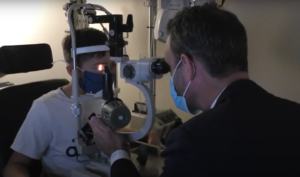sponsored content
January 3, 2023

David Hammond and Debbie Jones
John Sailer: Today, I’m with with Dr. David Hammond, Lead Clinical Scientist at CooperVision, and Dr. Debbie Jones, clinical scientist at the Centre for Ocular Research & Education. We’re going behind the scenes of the international seven-year MiSight 1 day clinical study to find out what went into a study of that scale.
Dr. Hammond, could you please recap what the MiSight 1 day clinical study involved?
David Hammond: Hi John, it’s great to be with you today, and Debbie.
The MiSight study is quite a complex study that spans seven years and evolved over time. In the first three years of the study, we did a traditional clinical paradigm, where the children were allocated to either a treatment group of MiSight 1 day or a control group of single-vision lenses. And these first three years of data led to that pivotal FDA approval* in proving the myopia control effect of that lens in age-appropriate children. After this time, we extended the study and between years four and six, all children were treated with MiSight 1 day. And then at the end of the study, in the final year, all of those children were then taken out of MiSight and put into single vision lenses to see what the effect would be when treatment was stopped.
Now this is the longest running soft contact lens study among children for myopia control, that we know of, and it had a diversity of clinical sites all around the world from Debbie in Canada, through Portugal, the United Kingdom, and Singapore, so it was a very diverse population.
Sailer: Ok, excellent. Now, Dr. Jones, can you tell us a bit about your role in the study?
Dr. Debbie Jones: Yeah, thanks, John. Delighted to share my perspective on being involved in the study. So, as you mentioned in the introduction, I’m a clinical scientist at the Centre for Ocular Research and Education, called CORE for short, as well as a professor at the School of Optometry. I was the lead investigator for the Waterloo site. We actually enrolled the largest number of participants in the study, 64 of the 144 total, so we were the biggest site of the four. And of course, we saw the participants according to protocol for their initial screening and then at regular intervals — which was a week, a month, three months, six months, and then six-monthly thereafter for the duration of the whole seven years.
As with any randomized clinical trial, of course, we were masked. So, the study was double-masked, with the lenses marked with “Lens A” or “Lens B” and nobody within CORE knew which lens was which, that included the participants and of course the researchers and the clinical assistants who were dispensing the lenses to the children.
At enrollment, children were aged 8 to 12, so we were seeing young children to be fit with lenses, but of course that meant by the end of the seven years, we were actually seeing participants changing from being young children at the initial visit to young adults and even driving themselves to the study visits, so it was quite novel to be able to follow these children right through their MiSight journey for those seven years.
Sailer: Interesting! That is a long time. So, now following up on that, when planning to take on research of this scale, what are some of the challenges that such clinical studies might face?
Jones: All clinical studies have challenges and the biggest ones are recruitment and then retention. Recruiting for a contact lens study for young children is certainly a challenge as parents are often initially reluctant and concerned about contact lens wear, primarily can their children handle lenses and would it be able to fit into their daily routine, so in those busy morning routines of getting kids off to school, would they be able to spend that extra time to put contact lenses in?
We found that providing clear instruction was essential and also reassuring that generally children are very capable of wearing and handling lenses1҂ and that helped to ease the concerns of the parent, and ultimately we had great retention rates throughout the whole of the study, throughout all the four sites, really demonstrating that kids as young as eight can be fit successfully with a MiSight contact lens, or indeed any contact lens, and wear them successfully for an extended period of time.
Of course, there are dropouts, and you have that with any clinical study. You have to expect that some patients, some participants, will drop out. Some families moved away, changes in lifestyle automatically led to dropout, but as I mentioned, the overall retention rate was really very good across the four sites, and I believe we had 108 participants continuing into Part Two of the study, so part the initial three years and actually continued on through to year six and year seven. So there are challenges, but with good education and good information, you can overcome those.
Sailer: Okay, good, excellent. Very interesting. Did anything else come up as the study progressed?
Dr. Hammond: Yeah, so after three years, it became very obvious that MiSight was very effective at treating myopia in this population. We saw a 59% on average treatment effect over that three years.† Debbie plays into this quite well with the conversations that she and the other sites around the world had when we wanted to extend this study. Originally, it was going to be three years, and when we wanted to extend the study, we were under a significant amount of pressure to actually change everyone into the MiSight group because the lens worked so well — it was a great problem to have.
And that’s part of the reason why we changed to this experimental paradigm, in that year four to year six of the study, over those three years, all the participants were put into a MiSight myopia control lens. And when we did that, we were really delighted that at the end of the six years, we actually had an experimental paradigm now, where we had children who had been treated for the entire six years in MiSight and for three years. And what we saw was that myopia control occurred in both of those groups in the final part of the study.
Sailer: Okay, great. And Dr. Jones, anything that you noticed come up during the study?
Dr. Jones: I would just follow on from what David just said. Even though it was a double-masked study, so that nobody knew what “Lens A” was or what “Lens B” was, it became evident early on in the study that one of the groups of age-appropriate* children — A or B — was not progressing with myopia compared to the other, so we were seeing no changes in refractive error, or minimal changes.1± So, whilst we remained masked, we had a good indication that something good was happening here, and it was actually quite heartwarming to have everyone then switched into what was the unmasked MiSight group at the end of the three years.
And of course, this was important in order to retain that group for three more years and in some cases into that fourth year, when we took the participants out of MiSight. So, it was really encouraging as a clinician when I’m looking at patients and how I managed them. The fact that we were managing the participants as we would a clinical patient, we were giving them a good opportunity to have their myopia progression slowed down. It was great to be part of that for this cohort of participants, who are really just regular people as they would be patients in a clinical practice.
The other thing was the slit-lamp findings, or indeed lack of slit-lamp findings. So, again, as a clinician, even in a clinical research study, of course you’re always aware of the ocular health of the participants and as a clinical study, as all studies, you’re doing very extensive slit-lamp assessments and making sure that the eyes remain heathy. Throughout those seven years, for the participants who stayed that long, there was very little to be seen, so we were confident that not only were the age-appropriate* participants getting the benefit of a myopia control product, they were also remaining very healthy from an ocular perspective. So, there were no ocular health issues to worry about.‡1,2
Sailer: That’s great! Possibly some good, unexpected outcomes there. So, going back to switching the control group — how did you handle not having a traditional control group after the switch?
Dr. Hammond: Yeah, that’s a great question, John. It was a challenge. It’s always challenging in a clinical study when you have a delayed treatment style group, so you’re not doing a traditional paradigm of a test to a control comparison, but fortunately we had a wealth of statistical methods available to assist in doing this. And we used quite a few different analysis methods of varying complexity.
First off, what we did quite simply, was we compared the rate of myopia progression in years three through six between the group that had recently all started MiSight at the three-year mark and those who had worn MiSight for the entirety of the six years, and what we found was that there was no difference in the rate of progression of the groups when they both wore MiSight 1 day in years three through six.2 And if we remember now that one of these groups had worn a single-vision lens for three years, well they were more myopic when they started MiSight at that four-year mark than the group that had worn MiSight already for the first three years, but we saw the myopia control effect was the same.*║Ω 4 And what this suggests is that the baseline myopia level when commencing treatment is not a factor in the generalizability of the treatment effect, and that’s really important.
But, what we also did because we didn’t have that concurrent control group, is we developed what’s called a virtual control group model. And the aim here was to produce a model of our control group data set that models the average myopia growth that would have occurred if treatment hadn’t been instigated, so if they were untreated. And therefore, we can model what the control group would have done if we had kept them in single vision lenses for the duration of the study.
The virtual control group modeling has been an excellent method of predicting treatment efficacy, and it has shown that age is the more important predictor of annual myopia progression than let’s say baseline myopia or axial length.
A really nice thing about the virtual control model we developed is that it’s actually concordant and aligns with a model presented by Mark Bullimore and Noel Brennan of untreated myopia growth, so it’s a nice independent validation that our model is accurate with others. And when we applied our virtual control model, it revealed a substantive myopia control effect through that full six years of treatment. Once again, it showed by another method that on average, MiSight 1 day contact lenses reduce myopia progression in age-appropriate* children by about half.*║Ω 3 With MiSight 1 day contact lenses, you can expect myopia progression in age-appropriate* children to slow by about 50% when treatment is commenced, and this will continue until you take the children out of the contact lenses for the entirety of the treatment.*║Ω 3,4
The last thing I’d say here is that in the seventh year of the study, we took all of the children out of the MiSight lenses and put them into single-vision lenses, and we once again used that virtual control model. It was really valuable, because when we took the children out of the MiSight lenses and back into single-vision, their myopia progressed on average what we would expect in our model for that same age group. And this was a great result because it provides another measure to support the validity of our virtual control model that we’ve used.
Sailer: Yeah, sounds like very clear results from that approach. It sounds like you learned something pursuing that particular type of analysis. What is it that others can learn from that type of approach?

Violet is one of the children who has been able to benefit from MiSight 1 day since its FDA approval.*
Dr. Hammond: So, what we’ve learned from this study and how it was structured is that it’s really important to look at the length of the myopia control treatment period and really, when an eye care practitioner is instigating treatment of a myopia control method, this isn’t a one-year commitment, this is a long-term commitment to that child to undertake myopia control. And the power of the study is that we’ve followed children from quite young ages, as Debbie said, all the way through their teenage years, and what we’ve found from this study is that there’s a long-term benefit to MiSight 1 day for myopia control.¶4 So, I think, with this in mind, it’s really important to think for any other myopia control therapies that come along, that there is an equivalent period of long-term research to demonstrate the usefulness and effectiveness of those treatments.
Sailer: Okay, and continuing onward, what would you like to see next in the research sphere?
Dr. Hammond: Yeah, we’re really excited about the growing body of research in the area of myopia. There are lots and lots of new studies and data coming out. And one thing that I’d like to say is that CooperVision is still the only company with an FDA,* and recently Chinese NPMA,** approval for a myopia control product for age-appropriate children.* And from personal experience, I can tell you that both the FDA and NMPA processes are rigorous in attaining approval for obtaining that indication. And really, I hope the future brings evaluation of different treatment options by regulators and the reason for this is that it increases the evidence base available to eye care practitioners when evaluating a myopia control device to help them see which device is most appropriate for their patients. And this is one of the driving forces behind the recent joint venture between CooperCompanies and EssilorLuxottica to enable SightGlass Vision to really accelerate their development process to commercialize spectacle lenses for myopia control.♦
So, while MiSight is still in age-appropriate children, we know that there will be other approved options that will be emerging in the U.S., and hopefully this helps once again bolster the standard of care for myopia control.
Sailer: Absolutely, yes, there are lots of treatments coming out for managing myopia. Thank you both for your insights you’ve shared today. Now, to wrap up, what would you say are the top takeaways for ECPs that they can apply to their practice?

MiSight 1 day wearer Adam visits Carillon Vision Care for a comprehensive eye exam.
Dr. Jones: David explained very nicely how the seven-year study demonstrated the efficacy of MiSight 1 day contact lenses to slow down the progression of myopia in that 8 to 12 age group at initiation of treatment, that certainly is a big takeaway from the clinical study and from the data that’s been published.
My overriding take-home message I think would have to be that we need to ensure as clinicians that all children receive eye care from a very early age and that we need to intervene as soon as myopia is evident. It’s just not acceptable to wait until progression is demonstrated. We know that myopia of course is not reversible and even though it’s not been stated as such, in many countries around the world we as clinicians really need to make myopia control as our standard of care for all myopia patients, even before the regulatory authorities tell us that we should do.
Sailer: Yes, agreed. Thank you both, Dr. Hammond and Dr. Jones for your time today, and we would also like to thank CooperVision for its continued sponsorship.
References
*U.S. Indications for use: MiSight 1 day (omafilcon A) soft (hydrophilic) contact lenses for daily wear are indicated for the correction of myopic ametropia and for slowing the progression of myopia in children with non-diseased eyes, who at the initiation of treatment are 8-12 years of age and have a refraction of -0.75 to -4.00 diopters (spherical equivalent) with ≤ 0.75 diopters of astigmatism. The lens is to be discarded after each removal.
**China Indications for use: MiSight is indicated for the correction of myopia for patients with non-diseased phakic eyes, who at the initiation of treatment are 8-12 years of age and have a refraction of -0.75 D to -4.00 D with ≤ 0.75 diopters of astigmatism; Meanwhile, it has the dual focal design with alternative multiple rings, which allows part of the light passing through the optical zone to focus in front of the retina, forming myopic defocus, and expecting to slow down the change of axial length of the patients. Fitting and evaluation of the product should be in medical institutions by ophthalmologists with intermediate title or above and conduct regular check. It must be used in strict accordance with the IFU requirements.
† Compared to a single vision 1 day lens over a 3-year period.
‡ No slit-lamp observations recorded above grade 2 at any visits apart from 1 observation of grade 3 GPC attributed to a foreign body at the 1 month visit.
҂ At initial dispense, 66/67 children successfully fit with MiSight 1 day aged 8-12 were able to handle their lenses.
║ Using measured and modeled data, pooled across ages (8-17), MiSight 1 day slowed myopia progression by an average of approximately 50%.
¶ While eyes are still growing; children fit ages 8-12 and followed for 6-years. n=40
§ Only FDA-approved soft contact lens designed for myopia control in the U.S.
Ω Myopic children fit with MiSight 1 day contact lenses ages 8-15 continued to experience slowed myopia progression as long as they remained wearing the lenses as prescribed.
± No clinically meaningful change in refractive error -0.25D or less from baseline.
♦ This product is not approved in all markets, including the U.S.
1 Chamberlain P, et al. A 3-year Randomized Clinical Trial of MiSight Lenses for Myopia Control. Optom Vis Sci. 2019; 96(8)556-567.
2 Chamberlain P, Arumugam B, Jones D et al. Myopia Progression in Children wearing Dual-Focus Contact Lenses: 6-year findings. Optom Vis Sci 2020;97(E-abstract): 200038
3 Arumugam B, Bradley A, Hammond D, Chamberlain P. Modelling Age Effects of Myopia Progression for the MiSight 1 day Clinical Trial. Invest. Ophthalmol. Vis. Sci. 2021;62(8):2333.
4 Chamberlain P et al. Long-Term Effect of Dual-Focus Contact Lenses on Myopia Progression in Children: A 6-year Multicenter Clinical Trial. Optom Vis Sci 2022 In Press.
5 Chamberlain P, Arumugam B, et al. Myopia progression on cessation of Dual-Focus contact lens wear: MiSight 1 day 7 year findings. Optom Vis Sci 2021;98:E-abstract 210049.
6 Hammond D, Arumugam B, et al. Myopia Control Treatment Gains are Retained after Termination of Dual-focus Contact Lens Wear with no Evidence of a Rebound Effect. Optom Vis Sci 2021;98:E-abstract 215130.














